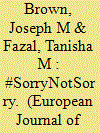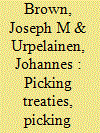|
|
|
Sort Order |
|
|
|
Items / Page
|
|
|
|
|
|
|
| Srl | Item |
| 1 |
ID:
181129


|
|
|
|
|
| Summary/Abstract |
States accused of perpetrating cyber operations typically do not confirm or deny responsibility. They issue ‘non-denial denials’ or refuse to comment on the accusations. These ambiguous signals are prevalent, but they are largely ignored in the existing cyber literature, which tends to treat credit claiming as a binary choice. The ambiguity of non-denial denials and ‘non-comments’ allows states to accomplish two seemingly opposed goals: maintaining crisis stability and leaving open the possibility of their involvement in the attack. By deliberately remaining a suspect, a state can manipulate rivals’ perceptions of its cyber capability and resolve. Refusing to deny responsibility can also shape rivals’ perceptions of allies’ capabilities, enhancing the credibility of deterrence. All of this can be accomplished without the escalatory risks that would come with an explicit admission of responsibility. Where previous research has focused on the dangers of escalation and the limitations of costly signalling with cyber, we show that non-denial denials and non-comments make cyber operations considerably more useful than the literature appreciates.
|
|
|
|
|
|
|
|
|
|
|
|
|
|
|
|
| 2 |
ID:
172847


|
|
|
|
|
| Summary/Abstract |
Terrorists attack civilian targets but there is variation in how many civilians they kill. Terrorists may deliberately harm civilians, or they may adopt a less bloody approach, demolishing businesses, transit systems, and other civilian property while employing tactics to avert civilian casualties. One such tactic is to warn civilians before an attack, allowing them to flee the area. With warnings as an example, this study considers why terrorists might adopt casualty-aversion tactics. An analysis of 12,235 bombings by 131 terrorist groups in the years 1970 to 2016 finds that warnings are most common when terrorists fight democracies and when they lack territorial strongholds. Ideological factors such as religion are not significant predictors of warnings. These findings suggest a need to revisit the claim that religion incentivizes indiscriminate terrorism. They also suggest a strategic logic behind casualty-aversion tactics. Terrorists fighting democracies may spare civilians to appear legitimate in citizens’ eyes. Terrorists without strongholds may spare civilians because they rely on the state's population for support. At first glance, my findings appear to contradict civil war literature arguing that militants with strongholds use violence more discriminately. However, terrorism occurs in areas of state control. Militants with strongholds can use indiscriminate terrorism against state-governed civilians without alienating their own supporters elsewhere.
|
|
|
|
|
|
|
|
|
|
|
|
|
|
|
|
| 3 |
ID:
175736


|
|
|
|
|
| Summary/Abstract |
This article builds a new theoretical framework to understand the role of threats in terrorism. Interviews of IRA members give rise to a speech/kinetic action model of terrorism, in which threats and violence jointly determine the physical consequences and political messages conveyed by terrorist attacks. In fact, threats are integral to the attack, and some attacks can be said to consist of threats alone. IRA interviews reveal four varieties of threats: warnings, hoaxes, pledges, and bluffs. These categories are distinguished by the timing of the threatened violence (immediate or prospective) and the intended truthfulness of the threat. The IRA interviews establish the function of each type of threat in influencing the beliefs or behavior of state and society. Threats may disrupt the economy, increase or decrease bloodshed, control social behavior, secure tactical or strategic advantage, claim attacks, aggrandize the perpetrator, and facilitate bargaining. A single threat may serve several of these functions, signaling different messages to different audiences. In fact, this is one of the most important applications of threats. When violence alone would produce suboptimal outcomes, threats alter the pattern of damage in a way that optimizes militants’ messaging for all audiences.
|
|
|
|
|
|
|
|
|
|
|
|
|
|
|
|
| 4 |
ID:
172177


|
|
|
|
|
| Summary/Abstract |
This paper presents a case study of the Earth Liberation Front (ELF), based on interviews of the group’s former affiliates. It examines the role of credit claims in organizing this underground leaderless resistance group’s activity. In addition to the external signaling functions of credit claims—demonstrating capability, issuing demands, and soliciting public support—credit claims serve a movement-building role in the ELF. By issuing credit claims in “aboveground” fora that other cells are known to read, ELF cells with no direct links are able to communicate information to one another. Credit-claiming communiqués serve four organizing functions for the ELF. They constitute the ELF underground as an imagined community, recruit new cells, set agendas for future actions, and enforce operational standards of behavior via an informal “peer review” process. This study of the ELF suggests broader insights, including possible organizing techniques that may be observed in white supremacist and Islamist cases.
|
|
|
|
|
|
|
|
|
|
|
|
|
|
|
|
| 5 |
ID:
141190


|
|
|
|
|
| Summary/Abstract |
International treaty negotiations and domestic politics are interrelated. We show that negotiators can strategically select treaties to mobilize domestic interest groups and support particular candidates for office. Interest groups will support (oppose) political parties that will ratify treaties benefiting (harming) them. By designing treaties that mobilize these “swing” groups, negotiators can affect different parties’ chances of assuming power. Our model produces specific predictions for treaty design, contingent on the preferences of negotiators, parties, and interest groups. With conservative and moderate interest groups, the results may be counterintuitive—for instance, foreign governments pushing liberal treaties on liberal incumbents they dislike, intentionally mobilizing interest groups against the treaty and in favor of conservative challengers. Highly competitive systems, particularly those where moderate interest groups’ support is in play, give treaty negotiators leeway to shape political outcomes. Powerful interest groups may exert strong influence or no influence, depending on the cost of appeasing them and whether domestic and foreign negotiators are willing to gamble the incumbent’s political future for the achievement of their policy ideals.
|
|
|
|
|
|
|
|
|
|
|
|
|
|
|
|
|
|
|
|
|